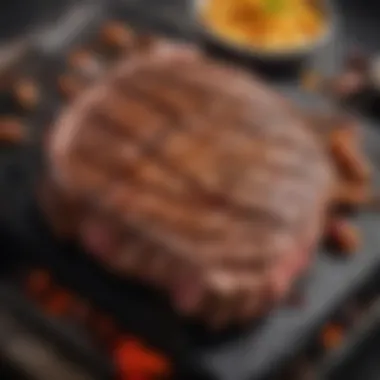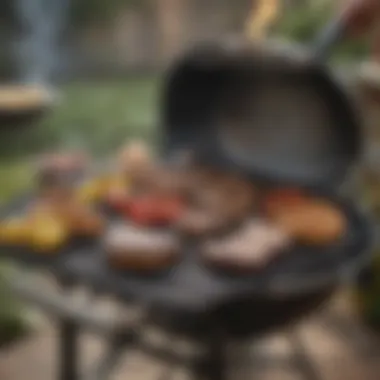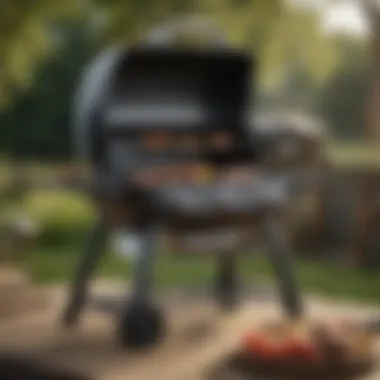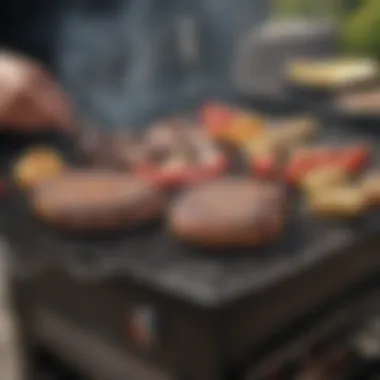Master the Art of Weber Charcoal Grilling


Intro
Weber charcoal grilling represents a time-honored method of outdoor cooking that transcends mere food preparation. It encompasses a blend of technique, equipment, and artistry. This form of grilling allows cooks to evoke rich flavors and aromas, creating memorable culinary experiences. For many, grilling is more than cooking; it is an expression of creativity and passion.
In this article, we explore the multiple facets of Weber charcoal grilling, from essential techniques to maintenance tips. This guide aims to demystify the process, making it accessible for novices while providing seasoned grillers with fresh insights.
Recipe Overview
Although we are not providing a specific recipe, understanding the essence of Weber charcoal grilling is fundamental. Whether one is grilling a basic steak or an elaborate feast, the principles remain the same. Each task requires attention to detail and a grasp of the underlying techniques.
Charcoal grilling with Weber provides a distinctive flavor profile that is hard to replicate. It brings out the natural goodness of the ingredients, enhancing their taste. The preparation becomes an art form, where one can experiment with various wood chips, seasonings, and methods to create something unique.
Grilling is not limited to just meat; vegetables, seafood, and even fruits can yield delicious results when placed on the grill. The precise control of temperature and smoke helps in achieving the desired outcomes. Charcoal, when properly managed, can provide heat for indirect cooking as well as searing. This flexibility stands as an advantage for those using Weber grills.
Understanding Weber Charcoal Grilling
Understanding Weber charcoal grilling is essential for anyone looking to refine their outdoor cooking skills. This section lays the groundwork by discussing the history and evolution of charcoal grilling, as well as the key principles that govern the practice. Familiarity with these concepts can greatly enhance your grilling experience, making it more enjoyable and effective.
History and Evolution
Charcoal grilling has a rich history that dates back centuries. Initially, people used open fires or pits to prepare their meals. The introduction of charcoal provided a more controlled cooking method, allowing for better heat retention and flavor development. Weber, a brand synonymous with quality grilling, entered the market in the mid-20th century. The iconic Weber kettle grill was invented in 1952 by George Stephen, who aimed to create a grill that could provide even heat distribution and protection from the elements.
Over the years, Weber charcoal grills have evolved in design and functionality. Today, the variety encompasses kettle grills, smokers, and portable options, all tailored to meet diverse grilling preferences. Understanding this evolution gives insight into the technology and craftsmanship behind Weber products, making them a staple for dedicated grill enthusiasts.
Key Principles of Charcoal Grilling
Charcoal grilling relies on a few fundamental principles that are crucial to mastering the technique. The first principle is the proper selection of charcoal. Different types of charcoal, such as lump charcoal and briquettes, have varying burn times and flavor profiles. Lump charcoal burns hotter and offers a more natural flavor, while briquettes provide consistent heat and are easier to use for beginners.
Another critical factor is heat management. Grilling effectively requires an understanding of direct and indirect heat. Direct heat is suitable for searing meats, while indirect heat allows for slow cooking, minimizing flare-ups. Additionally, understanding heat zones is vital. This refers to creating areas on the grill with different temperatures, which can be achieved using the two-zone setup. In one zone, charcoal is piled up for high heat, while the other side remains free of charcoal for low heat.
Lastly, the preparation and monitoring of your food are important. Marinating and seasoning can enhance flavors, while checking temperatures with a reliable grill thermometer ensures that food is cooked safely and to the desired doneness.
"Mastering the principles of charcoal grilling transforms ordinary meals into extraordinary culinary experiences."
These foundational principles provide a framework for both new and seasoned grillers as they explore the vast world of Weber charcoal grilling.
Choosing the Right Weber Charcoal Grill
Selecting the right Weber charcoal grill is crucial for achieving optimal grilling results. With various options available, understanding the distinctions between them can enhance your outdoor cooking experience. Each grill type caters to different styles and aspects of grilling, which adds versatility to your culinary endeavors.
Types of Weber Charcoal Grills
Kettle Grills
Kettle grills are iconic in the world of charcoal grilling. Their round design allows for even heat distribution, which is essential for proper cooking. Kettle grills are designed with a lid that locks in smoky flavors, providing a more authentic grilling experience.
These grills are popular due to their effective heat management, allowing for both direct and indirect cooking methods. One unique feature of kettle grills is the dampers located on the lid and bowl, which help control airflow and temperature.
The main advantage of kettle grills is their affordability and ease of use, making them an excellent choice for beginners. However, the limited size may not suffice for large gatherings.
Smokers
Smokers are designed for those who want to experiment with flavors through slow cooking. Unlike standard grills, these units maintain a lower temperature over an extended period, allowing meat to absorb smoke. The key characteristic of smokers is their ability to create rich, complex flavors, which is often hard to achieve with regular grilling.
One notable feature is the separate compartments for charcoal and smoking wood, promoting direct and indirect heat sources.
Smokers are excellent for individuals who enjoy BBQ-style cooking, yet they require more time and attention. This can be a disadvantage if you aim for quick meals.
Portable Grills
Portable grills offer a solution for those who cannot commit to a large setup. Their compact size makes them convenient for picnics, camping trips, or tailgating. The main appeal of portable grills is their mobility; they are lightweight and easy to carry. A unique feature of these grills is their foldable legs or lightweight materials, which enhance portability. While portable grills provide flexibility, they often have a reduced cooking area, which might limit the amount of food you can prepare at once. Nonetheless, they are a good choice for casual outdoor cooking.
Factors to Consider When Selecting
When deciding on a Weber charcoal grill, several factors come into play that can greatly influence your satisfaction and grilling success.
Size
The size of your grill matters significantly. A larger grill accommodates more food, which is essential for gatherings. However, it requires more space and charcoal. Medium-sized grills often strike a balance, being versatile for both small and larger meals. The choice depends on your cooking needs and outdoor space.
Material
Material directly affects durability and heat retention. Stainless steel grills tend to last longer and resist rust, while porcelain-coated grills provide better heat control. Consider your climate and frequency of use to select the appropriate material that suits your grilling style.
Features
Grill features can enhance usability. Digital temperature gauges, adjustable vents, and built-in heaters are some useful aspects to look for. These tools assist in maintaining consistent cooking conditions.
Ultimately, choosing the right Weber charcoal grill tailors your grilling experience, allowing you to achieve flavorful results while accommodating your lifestyle.
Essential Charcoal Grilling Techniques
Understanding essential charcoal grilling techniques is fundamental to achieving optimal results when cooking with your Weber grill. These techniques not only ensure that food is cooked thoroughly but also enhance flavors and textures that are characteristic of charcoal grilling. Recognizing how to manage heat and create the right cooking environment is vital.
Making the Perfect Charcoal Fire


Creating a proper charcoal fire is the cornerstone of effective grilling. Using a chimney starter can simplify this process significantly. Fill the chimney with charcoal briquettes and ignite newspaper or fire starter at the bottom. Once the top layer becomes ash-gray, you can pour the hot coals into the grill.
Another method is the "two-zone" setup. By placing coals on one side of the grill, you create direct and indirect heat. This setup provides a space for searing and another for slower cooking. Both methods are effective, but controlling the temperature is essential. A well-constructed fire allows for even cooking and helps to avoid flare-ups.
Direct vs. Indirect Heat
Choosing between direct and indirect heat is an important decision that affects the cooking time and flavor of your food. Direct heat involves placing food directly over the flames. This method is ideal for quick-cooking meats like burgers or steaks, creating a flavorful crust while keeping the inside juicy.
In contrast, indirect heat requires food to be placed away from the coals. This technique is suitable for larger cuts of meat, such as whole chickens or ribs, allowing them to cook through without burning the exterior. Understanding when to use each method will greatly improve your grilling outcomes.
Understanding Heat Zones
Understanding heat zones within your grill is pivotal for controlling how your food cooks. As mentioned previously, a two-zone setup allows for different temperatures on each side of the grill. Keeping one side hot for searing and the other cooler for slow cooking enables effective meal preparation in one cook.
Furthermore, it is important to gauge the actual temperature of these zones. A reliable grill thermometer can assist with this, ensuring you adjust your technique as needed. Keeping in mind the varying temperatures will help you manage cooking times and achieve the desired doneness without overcooking.
Key Takeaway: Mastering these essential techniques will transform your charcoal grilling experience. From making the fire to understanding heat dynamics, each skill contributes to achieving delicious results on your Weber grill.
Grilling Techniques and Tips
The section on grilling techniques and tips is crucial for mastering Weber charcoal grilling. It delves into the various methods and approaches that can elevate the grilling experience. Understanding these techniques enhances not only the flavor but also the efficiency and enjoyment of the grilling process.
Meat Preparation
Proper meat preparation is vital for achieving the best results on the grill. This begins with selecting quality cuts. Choose fresh meats that are free from blemishes. Next, trimming excess fat can prevent flare-ups and ensure even cooking.
Marinating plays a key role too. Allow the meat to soak in flavors for several hours or overnight. This can improve juiciness and infuse delicious taste. Additionally, bring meats to room temperature before cooking. This can help them cook evenly.
Vegetable Grilling Techniques
Grilling vegetables requires different approaches compared to meats. First, selecting the right vegetables is essential. Firm varieties like bell peppers, zucchini, and asparagus hold up well under high heat. Slice them adequately; thicker pieces may require a longer cooking time.
Using skewers or grill baskets can simplify handling. This technique minimizes the chance of smaller pieces falling through the grill grates. Additionally, tossing vegetables in olive oil and seasoning beforehand enhances the flavor and caramelizes their natural sugars.
Using Marinades and Rubs
Best Practices
Marinades and rubs are effective tools for adding flavor to grilled items. A good marinade generally consists of an acidic component, such as vinegar or lemon juice, along with oils and herbs. This combination tenderizes the meat while infusing rich flavors.
For rubs, a mix of spices and herbs is used. Applying rubs prior to grilling allows flavors to penetrate the surface. The key characteristic of best practices in using rubs is balancing flavors. Too much salt or overpowering spices can ruin a dish, while a well-balanced rub enhances the natural taste.
The unique feature of marinades and rubs is their versatility. They can be adjusted to suit personal preference, making them a popular choice for unique flavor experiences in grilling.
Common Mistakes
One area of concern in marinades and rubs is the timing of application. Many people make the mistake of marinating for too long, which can break down the meat too much. A general rule is to marinate for 30 minutes to a few hours, depending on the cut.
Another common mistake is not dry rubbing effectively. If the surface is too wet, including marinated items, the rub will not adhere properly. The unique feature of common mistakes involves the misunderstanding of flavors.
When an excess of spice is applied, the intended taste can be lost. It's crucial to apply with caution. This ensures the grilling skills are enhanced rather than hindered.
"Proper preparation and understanding your ingredients can transform your grilling experience."
In summary, developing good grilling techniques and honing them pays immense dividends. With attention to the preparations for both meat and vegetables, and careful application of marinades and rubs, the outcome will impress all grill lovers.
Weber Accessories for Charcoal Grilling
Weber charcoal grilling goes beyond just the grill itself. Accessories play a crucial role in enhancing the grilling experience, leading to better results and more enjoyable cooking. This section will cover essential tools and optional enhancements available for Weber charcoal grilling. Knowing which accessories to incorporate will elevate your skills and ultimately improve the quality and enjoyment of your meals.
Essential Tools
Grill Tools
Grill tools are fundamental in managing and executing a successful grilling session. These include spatulas, tongs, and grill baskets. Each tool has characteristics that adapt uniquely to various grilling needs. For instance, tongs are very versatile and allow the cook to turn and move food without piercing it. This is very important, as piercing can lead to juices escaping, which affects flavor and moisture.
One significant aspect of quality grill tools is the materials they are made from. Stainless steel is a popular choice. It is durable and designed to withstand high heat. Users find stainless steel tools easy to clean. However, some cheaper options may be made from less robust materials. This choice could result in bending or breaking.
Aprons
Wearing an apron is an often-overlooked but essential aspect of charcoal grilling. The main purpose of an apron is protection. It shields clothing from spills and splatters, which can be common when grilling. A good apron typically has pockets, allowing grillers to keep tools and condiments within reach.
For Weber grilling, aprons designed with heat-resistant material can add an extra layer of safety. While cotton aprons are comfortable, they may not offer the protection against heat that some high-temperature grilling involves. Therefore, selecting an apron that combines comfort with heat-resistant qualities is a wise choice.
Gloves
Grilling gloves often come in handy when handling hot items or adjusting grill components. The key characteristic to look for in gloves is heat resistance. It is vital to protect the hands from burns. Silicone gloves are becoming increasingly popular, as they provide dexterity while ensuring a firm grip.


Unique to grilling gloves is their water-resistance feature. This can be beneficial when managing wet or greasy foods. Some gloves may be machine washable, making care easy. However, others might require manual cleaning, which can be inconvenient. Choosing gloves with good heat resistance and easy maintenance will greatly enhance the grilling experience.
Optional Enhancements
Grill Thermometers
Precision in cooking temperature is vital in achieving great results during Weber charcoal grilling. Grill thermometers allow for accurate readings so that food is cooked properly. With wireless options available, they provide convenience to grillers who may want to monitor temperatures without being near the grill constantly.
A unique feature of digital thermometers is their quick reading time. They can effectively reduce the guesswork involved in grilling, ensuring that meats are not undercooked or overcooked. However, it’s important to be aware that cheaper thermometers may lose accuracy over time, which can affect cooking quality.
Grill Covers
Grill covers are often necessary for protecting Weber charcoal grills from the elements when not in use. A well-fitted cover will shield your grill from rain, dust, and debris. This feature prolongs the lifespan of the grill by preventing rust and corrosion.
Look for grill covers that are weather-resistant and have a good fit, as these qualities help in effective protection. Some covers might have added features like pockets for storing tools, though keep in mind that heavy materials might be cumbersome. A balance between protection and ease of handling is key when selecting a grill cover.
Overall, accessories can significantly enhance the charcoal grilling experience. By investing in essential tools and optional enhancements, grillers can enjoy better cooking results and greater convenience.
Maintenance of Weber Charcoal Grills
The maintenance of Weber charcoal grills is a crucial topic for any enthusiast looking to get the most out of their grilling experience. Proper care not only extends the life of the grill but also ensures that each grilling session is successful. Without regular maintenance, a grill can fall into disrepair, leading to performance issues, food safety concerns, and ultimately a less enjoyable cooking experience.
Routine Cleaning Practices
Routine cleaning should be a primary aspect of your maintenance strategy. After each use, taking time to clean the grill can prevent grease buildup and eliminate food residue that can produce off-flavors in future meals.
- Cleaning the Grates: Use a grill brush to scrub the grates while they are still warm. This will help to remove any stuck bits of food. Afterwards, a wipe down with oil will prepare them for next time.
- Ash Management: Ensure the ash catcher is emptied after each grilling session. Charcoal ash can attract moisture and lead to rust.
- Interior Inspection: Regularly inspect the interior of the grill for signs of damage, such as cracks or corrosion. Addressing these issues promptly can save you from more significant repairs later.
Long-Term Care
Long-term care for a Weber charcoal grill involves more than just routine cleaning. It focuses on ensuring that your grill remains in top condition for many seasons to come.
Storage Tips
Proper storage of your Weber grill is fundamental in preserving its lifespan. When storing your grill, consider the following:
- Location: Store the grill in a dry place, away from elements that may cause rust or corrosion, such as rain or snow.
- Covering: Use a grill cover to protect it from dust and debris. A well-fitted cover will shield it from moisture while allowing necessary airflow to prevent mold.
Using these storage tips can significantly extend the life of your grill, as it reduces the risk of weather-related damage.
Seasonal Maintenance
Seasonal maintenance is another important aspect of keeping your Weber grill in optimal condition. Each grilling season may require specific checks and adjustments:
- Deep Cleaning: At the beginning of each season, perform a thorough clean by removing all parts of the grill that can be taken off. Scrub each part with soapy water and let them dry completely before reassembling.
- Check for Wear: Inspect the grill, especially the ignition components and hoses (if applicable), for any signs of wear and tear. Replacing worn-out parts before your first use ensures safety and efficiency.
By maintaining your grill seasonally, you can maintain its functionality and prolong its longevity. Regular care minimizes risks and maximizes rewards in your grilling endeavors.
Safety Considerations in Charcoal Grilling
When engaging in charcoal grilling, safety cannot be overlooked. Ensuring a safe grilling environment is essential not just for the grillers but also for those nearby. This section will explore key safety aspects crucial for an enjoyable grilling experience.
Fire Safety Guidelines
Fire safety is paramount when using charcoal grills. Here are some guidelines to keep in mind:
- Location: Always place the grill in an open area, away from flammable materials such as leaves, wood piles, and structures.
- Stable Surface: The grill should sit on a stable surface to prevent tipping or accidental spills.
- Supervision: Never leave the grill unattended while lit. Fires can spread quickly if not monitored.
- Extinguishing Flames: Have a fire extinguisher nearby. If a fire starts, using water or other suitable tools should be immediate.
- Proper Disposal: Wait until the charcoal is completely cold before disposing of it in metal containers to avoid unintended fires.
"Staying vigilant while grilling is the best way to ensure that your barbecue remains a pleasurable experience."
Handling Charcoal Safely
Proper handling of charcoal is crucial for maintaining safety. Follow these recommendations:
- Tools: Use long-handled tools to minimize burning risks. This includes tongs and spatulas.
- Lighting Agents: Opt for lighter fluids specifically intended for charcoal. Avoid using gasoline or kerosene, which can lead to explosions or uncontrollable flames.
- Ventilation: Always grill in well-ventilated areas. Charcoal produces carbon monoxide, which is dangerous in enclosed spaces.
- Heat Protection: Wearing gloves designed for heat resistance can prevent burns when handling hot components.
- Awareness: Be mindful of hot surfaces. All parts of the grill can remain hot long after cooking has finished, and touching them can lead to serious burns.
By adhering to proper safety measures, grillers can ensure not only their safety but also the well-being of those around them. Grilling can be a delightful activity when approached with caution and knowledge.
Exploring Flavor through Charcoal Grilling
Grilling with charcoal offers a unique depth of flavors that gas grilling cannot replicate. This section highlights the significant ways charcoal grilling enhances the taste of food, focusing on key elements like smoke infusion, temperature control, and the artisanal touch that Weber products contribute to outdoor cooking.
Charcoal grilling invites creativity and experimentation. It transforms the ordinary experience of grilling into an exploration of flavors, leading to dishes that are rich, aromatic, and satisfying. A key advantage of using charcoal is the ability to infuse a delightful smoky essence into your food. Understanding how to manipulate flavors effectively is essential for creating meals that rival the best restaurants.
Using Wood Chips for Smoking
Wood chips can significantly elevate the flavor profile of grilled foods. By incorporating wood chips, such as hickory, mesquite, or applewood, grillers can add layers of complexity to their dishes. The choice of wood influences the final taste, making it imperative to select chips that suit the type of meat or vegetable being grilled.


To use wood chips effectively, soak them in water for about thirty minutes prior to grilling. This pre-soaking process allows the chips to smolder rather than flare up, creating a steady stream of smoke that envelops the food in flavor over a period of time. When placed directly on the hot coals, the wood chips will start releasing smoke as they heat up, enhancing the grilling experience.
When smoked properly, foods can gain a robust flavor that complements their natural attributes. Here are a few tips to remember when using wood chips for smoking:
- Select the Right Size: Use chips that are small enough to catch fire but large enough to smolder.
- Mix and Match Flavors: Combine different types of wood chips for your unique flavor profile.
- Pre-soak the Chips: As mentioned, this step is crucial for a consistent smoke.
"The essence of wood smoke adds an artisanal dimension to charcoal grilling, ensuring your dishes do not just taste good, but resonate with rich, layered flavors."
Duplicating Restaurant Flavors at Home
Recreating the exceptional flavor found in restaurants can seem daunting, but with Weber charcoal grilling, it is entirely possible. Understanding the mechanisms behind flavor development can empower home cooks to elevate their grilling. One fundamental aspect to replicate restaurant-quality taste is the use of high-quality ingredients and the right techniques.
Begin with fresh, high-quality meats and produce. Marinades play a pivotal role in enhancing flavors. A mixture of herbs, spices, and acidic elements such as lemon juice can tenderize and infuse the food with depth. Additionally, applying the right amount of seasoning is essential; professional chefs often rely on a careful balance that home cooks can replicate with practice.
Key techniques to focus on include:
- Searing Meat: Direct heat will create a crust, locking in moisture and flavor.
- Resting Time: Allowing grilled meat to rest for a few minutes post-cooking helps redistribute the juices, adding to the overall taste.
- Experimenting with Heat Levels: Different cooking temperatures change how food develops flavor. Understanding indirect and direct heat can be beneficial for achieving ideal results.
Investing time in these practices can allow anyone to mimic the flavors they encounter in professional kitchens. Through patience and dedication, the complex, restaurant-quality tastes achievable with Weber charcoal grilling can soon be a staple in your outdoor cooking repertoire.
Weber Charcoal Grilling Recipes
Grilling with Weber charcoal offers not just a cooking method but also a chance to explore flavors and techniques. Recipes play a crucial role. They guide you in effectively using your grill, which is essential whether you are preparing a simple family meal or hosting a barbecue gathering. The recipes presented in this section provide practical applications of previously discussed grilling strategies. Furthermore, they highlight the unique flavors and textures that Weber grills can help you achieve.
Marinated Grilled Chicken
Marinated grilled chicken is a classic dish that showcases the versatility of Weber charcoal grilling. The marinade infuses the meat with rich flavors, while the grilling process adds the desired char and smoke. You can use a variety of marinades, ranging from simple oil and vinegar mixtures to complex spice blends.
To prepare this dish:
- Choose your chicken cuts, such as thighs or breasts.
- Prepare a marinade using ingredients like olive oil, garlic, lemon juice, and herbs. Allow the chicken to marinate for at least two hours, or preferably overnight.
- Preheat your Weber charcoal grill and set up heat zones for better cooking results. Grill the chicken over direct heat for a few minutes on each side.
- Finish cooking the chicken on indirect heat until it reaches a safe internal temperature of 165°F.
Marinated grilled chicken not only offers fantastic taste but also retains juiciness due to the marinade.
Grilled Vegetable Skewers
Grilled vegetable skewers are another delightful recipe ideal for Weber charcoal grilling. These skewers allow for creativity and can be customized depending on your preference and seasonality. Common vegetables include bell peppers, zucchini, mushrooms, and cherry tomatoes.
Here is how to prepare your skewers:
- Chop your chosen vegetables into similar-sized pieces for even cooking.
- Soak wooden skewers in water for about 30 minutes to prevent burning.
- Thread the vegetables onto the skewers, alternating for visual appeal.
- Brush with olive oil and season with salt, pepper, and herbs.
- Grill over medium heat, turning occasionally. Cook until tender and slightly charred.
These skewers complement any grilled meat and can also serve as a tasty vegetarian option.
Smoked Ribs
Smoked ribs are a challenging yet rewarding dish that epitomizes the depth of flavor Weber charcoal grilling can achieve. This recipe requires a longer cooking time, but the result is incredibly tender and flavorful ribs.
To prepare smoked ribs:
- Select either pork or beef ribs, depending on your preference.
- Apply a dry rub made of spices such as paprika, brown sugar, cumin, and cayenne pepper. Let the ribs rest for at least an hour to absorb the flavors.
- Set up your Weber grill for indirect cooking. Use a combination of charcoal and wood chips for smoke, such as hickory or applewood.
- Place the ribs on the grill away from direct heat. Maintain a consistent temperature of around 225°F to 250°F.
- Smoke the ribs for several hours, basting occasionally with a barbecue sauce if desired.
The result will be ribs that have a perfect balance of smokiness and tenderness, elevating any gathering you host.
Community and Resources
The realm of Weber charcoal grilling expands far beyond just the equipment and techniques. Community and resources play a crucial role, serving as a foundation for sharing knowledge, experiences, and inspiration. Engaging with a community can enhance your grilling experience, whether through online forums or local groups. These platforms offer a wealth of insights, tips, and support from fellow enthusiasts, making the journey of mastering charcoal grilling a collaborative one.
Participating in these communities provides numerous benefits. Firstly, they deliver real-life advice and suggestions from those with practical experience. The feedback generated can lead to new ideas and methods that can elevate your grilling skills. Secondly, these groups often feature competitions and gatherings, creating opportunities for networking and camaraderie among members. In essence, they transform the practice of grilling from a solitary activity into a shared passion.
Considerations about community involvement focus on finding the right groups that align with your grilling interests. Some communities are dedicated to specific grilling techniques, like smoking or direct grilling, while others may be more general. Understanding your personal goals with grilling can help guide you to the most suitable resources.
"The true art of grilling is not just in the cooking but in the sharing of knowledge and camaraderie with fellow enthusiasts."
Online Forums and Groups
Online forums and groups dedicated to Weber charcoal grilling can provide a diversified platform for learning and sharing. Websites like Reddit host numerous threads where grillers exchange ideas and tips. Threads are often filled with user-generated content that showcases different grilling styles, recipe experimentation, and troubleshooting advice. Engaging with these platforms allows for direct interaction with a wide range of perspectives, making it easier to explore new techniques and solutions for common issues.
Benefits of joining online grilling communities include:
- Immediate access to collective wisdom.
- Real-time answers to specific questions.
- Learning from fellow members' successes and mistakes.
- Opportunities to share personal experiences and advice.
These interactions foster a sense of belonging and encourage consistency in improving skills in Weber charcoal grilling.
Books and Publications on Grilling
Books and publications serve as invaluable resources for anyone serious about Weber charcoal grilling. They offer structured and comprehensive insights into grilling techniques, recipes, and maintenance practices. Renowned authors in the grilling community often share personal experiences, curated recipes, and tested methods that are essential for both novice and experienced grillers.
Exploring various publications can reveal unique grilling styles and methods that you may not have previously considered. Books like "Weber's Big Book of Grilling" offer an extensive range of recipes and grilling tips that are specifically tailored to Weber products. These resources serve as both instructional guides and sources of inspiration for honing your craft.
Key considerations when selecting grilling literature include:
- Focus on specific techniques that interest you.
- Look for books that cater to different skill levels.
- Seek materials with practical tips on equipment care and maintenance.
Grilling literature equips you with not just recipes, but also a deeper understanding of the science behind grilling, enabling you to refine your approach and techniques.















